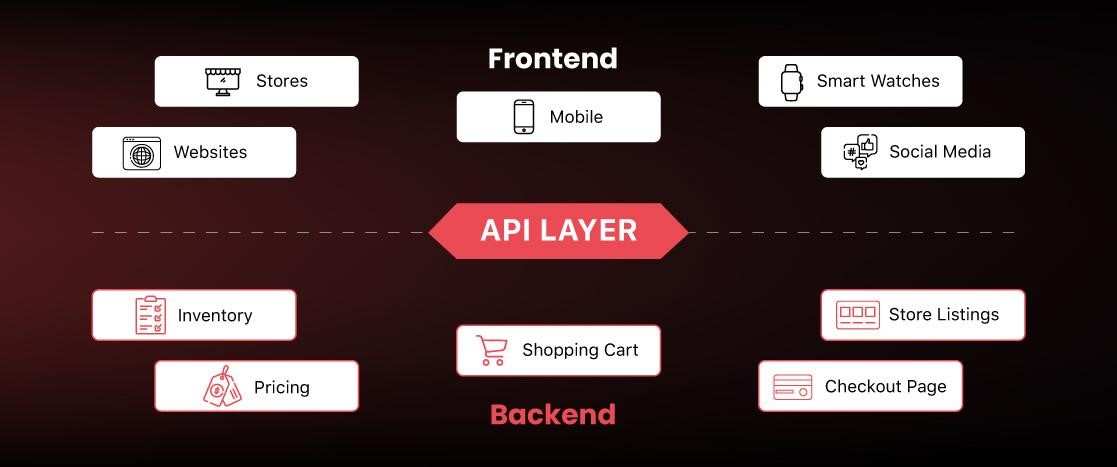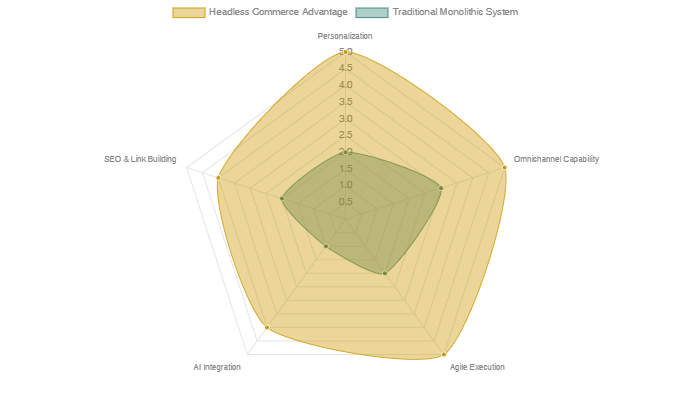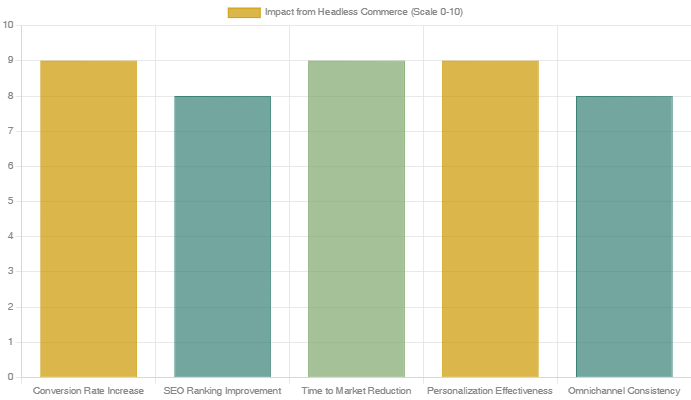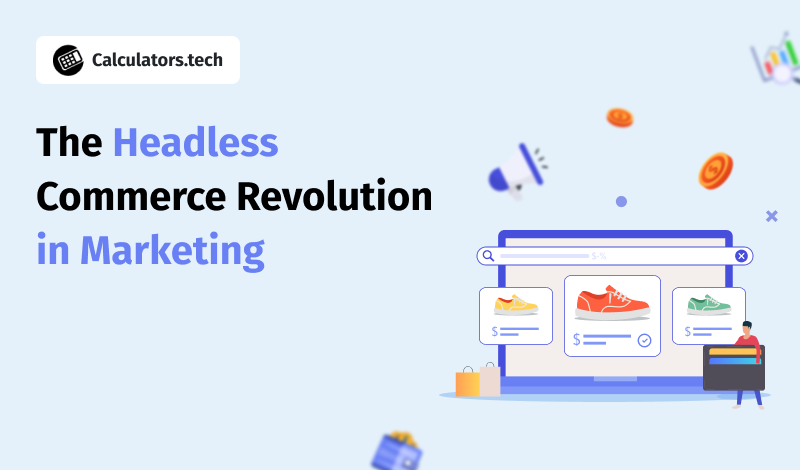Key Insights into Headless Commerce for Marketing Success
◀ Decoupled Architecture for Agility: Headless commerce separates the frontend (customer interface) from the backend (commerce operations), enabling marketers to deploy updates, A/B tests, and new customer experiences rapidly without disrupting core systems.
◀ Data-Driven Personalization and AI Integration: The flexibility of headless platforms allows for deep integration of data science, enabling real-time analysis of customer behavior, personalized product recommendations, and the seamless incorporation of AI tools like predictive analytics and content generation.
◀ Enhanced SEO and Link Building: Headless commerce facilitates faster site speeds, greater content flexibility, and robust integrations, all of which are crucial for improving search engine rankings, attracting high-quality backlinks, and building strong domain authority.

Visualizing the architectural shift: from monolithic to headless commerce.
The Strategic Imperative of Headless Commerce in Modern Marketing
In today's fiercely competitive digital landscape, leading marketing companies are strategically embracing headless commerce to gain a significant advantage. This innovative architectural approach, which decouples the customer-facing frontend from the operational backend, offers unprecedented flexibility and control. This separation is not merely a technical detail; it's a fundamental shift that empowers marketing teams to iterate faster, personalize experiences more deeply, and optimize their strategies with greater precision. By combining headless commerce with best ecommerce SEO services, businesses can respond to market dynamics with agility—delivering tailored customer journeys that drive conversion, enhance brand loyalty, and secure market leadership.
Revolutionizing Customer Experiences Through Data Science
At the core of headless commerce's impact on marketing lies its ability to facilitate advanced data science platforms. With the frontend liberated from backend constraints, marketers can collect and analyze vast amounts of customer data across diverse touchpoints – from web and mobile apps to social media and emerging digital interfaces. This data becomes the bedrock for highly personalized and engaging customer experiences.
Real-time Personalization and Predictive Analytics
Headless platforms enable real-time data processing, allowing AI algorithms to analyze browsing history, purchase patterns, and abandoned cart data on the fly. This empowers dynamic product recommendations, tailored content delivery, and personalized promotions that resonate deeply with individual customers. Companies like Nike and Coca-Cola exemplify this by leveraging proprietary data on headless platforms to create unique shopping journeys, leading to increased customer retention and conversion rates. The ability to quickly deploy data-driven insights ensures that marketing messages are always relevant and impactful.
AI Integration for Enhanced Efficiency
The API-first nature of headless commerce makes it exceptionally easy to integrate AI tools directly into marketing workflows. This includes everything from AI-powered content creation (e.g., using large language models like ChatGPT for marketing copy or product descriptions) to sophisticated customer support chatbots and predictive analytics models that forecast customer trends and optimize marketing spend. This automation and intelligence significantly boost efficiency and effectiveness, allowing marketing teams to focus on strategic initiatives rather than manual tasks.

This radar chart illustrates the comparative strengths of headless commerce versus traditional monolithic systems across key marketing capabilities, based on their inherent architectural advantages.
Optimizing Link Building and SEO for Organic Growth
Beyond personalization, headless commerce significantly bolsters a company's SEO and link-building efforts. The technical flexibility offered by a decoupled architecture directly translates into better search engine performance and a stronger backlink profile.
Faster Site Performance and SEO Advantages
One of the immediate benefits of headless commerce is the ability to create lightning-fast websites and applications. By separating the frontend, developers can utilize modern frameworks and optimization techniques that lead to superior page load times. Faster sites not only improve user experience but are also heavily favored by search engines, leading to higher rankings and reduced bounce rates. This direct impact on core SEO metrics is a powerful advantage in competitive markets, especially when supported by strategies driven through Crypto Market Making to enhance visibility and liquidity.
Flexible Content Strategies for Link Acquisition
Headless commerce empowers marketers to create and manage content with unprecedented flexibility. They can rapidly build content hubs, blogs, and landing pages optimized for specific keywords and user intent without being constrained by rigid backend structures. This agility facilitates the creation of high-quality, shareable content—such as infographics derived from proprietary data or in-depth industry reports—which naturally attracts authoritative backlinks. Partnering with streak ranker for your brand growth by niche-relevant, high-quality backlinks service that boost search visibility. Data analytics plays a crucial role here, guiding content creation by identifying trending topics, competitor backlink profiles, and high-quality backlink opportunities. This data-driven content strategy enhances domain authority and drives organic traffic.
The Power of Omnichannel Marketing and Agile Execution
Headless commerce is intrinsically aligned with the principles of omnichannel marketing, allowing businesses to deliver a cohesive and consistent brand experience across every customer touchpoint. Its API-driven nature enables seamless integration with diverse sales channels - from traditional web storefronts to emerging platforms - while simultaneously supporting sales pipeline development through improved lead tracking and conversion opportunities.
Seamless Multi-Channel Presence
With a headless architecture, product data, customer profiles, and content can be centrally managed and then pushed out to any channel via APIs. This means a customer can start their journey on a social media ad, continue browsing on a mobile app, and complete their purchase on a desktop website, all while experiencing a unified brand narrative. This consistency builds trust and loyalty, significantly reducing customer acquisition costs.
Faster Time to Market and Continuous Optimization
The decoupled nature of headless commerce empowers marketing and development teams to work in parallel. Marketers can launch campaigns, update content, or introduce new features rapidly without dependencies on backend development cycles. This agility supports continuous optimization, allowing companies to quickly A/B test different layouts, promotional offers, or content formats, even integrating creative variations built with an Instagram ad maker. The ability to swiftly adapt to market trends and customer feedback is a critical differentiator, enabling businesses to stay ahead of the curve and maintain a competitive edge.

A marketing team collaborating on data analytics, a key aspect of headless commerce strategy.
Key Headless Commerce Platforms and Their Impact
The market for headless commerce platforms is robust and growing, with various solutions catering to different business needs. These platforms provide the underlying infrastructure that enables the marketing strategies discussed above. Here’s a look at some prominent players and the benefits they offer:
Platform | Key Benefit for Marketing | Examples of Use |
Shopify Plus | Scalability, ease of integration with marketing apps. | Growing brands need robust, flexible storefronts. |
BigCommerce | Open SaaS platform, extensive API capabilities for customization. | Companies focused on highly tailored customer journeys. |
BigCommerce | Comprehensive suite for CRM and commerce, strong personalization. | Enterprise-level businesses require unified customer data. |
Adobe Commerce (Magento) | Highly customizable, strong community support, headless options. | Businesses need deep control over their tech stack. |
Commercetools | API-first, cloud-native, composable architecture. Enterprises | Enterprises building highly modular, future-proof systems. |
Strapi/PayloadCMS | Headless CMS, ideal for content-rich experiences & SEO. | Companies prioritizing content marketing and SEO. |
These platforms provide the foundation for marketers to build bespoke experiences, integrate best-in-class tools, and maintain competitive agility. The projected growth of the headless commerce market, estimated to reach $13.2 billion by 2035, underscores its increasing importance in the digital retail landscape.
Visualizing the Marketing Impact of Headless Commerce
To further illustrate the tangible benefits of headless commerce for marketing companies, the following bar chart provides a comparative view of key performance indicators that are significantly boosted by this architectural shift. These metrics highlight how a decoupled approach directly translates into improved marketing outcomes.

This bar chart presents an opinionated assessment of how headless commerce positively influences key marketing performance indicators, measured on a scale of 0 to 10.
Conclusion:
In conclusion, the best marketing companies in 2025 are not just adopting headless commerce; they are mastering it as a strategic asset to win in highly competitive markets. By decoupling the frontend and backend, they unlock unparalleled flexibility for data science applications, enabling deep personalization and AI integration that truly resonates with customers. This architecture also supercharges SEO and link-building efforts through faster site performance and dynamic content capabilities. The agility to adapt to market trends, launch campaigns rapidly, and maintain a consistent omnichannel presence positions these companies at the forefront of digital innovation, driving higher conversion rates, greater customer loyalty, and ultimately, sustainable market leadership. Headless commerce is no longer just a technical choice; it's a fundamental business strategy for future-proofing marketing success.
